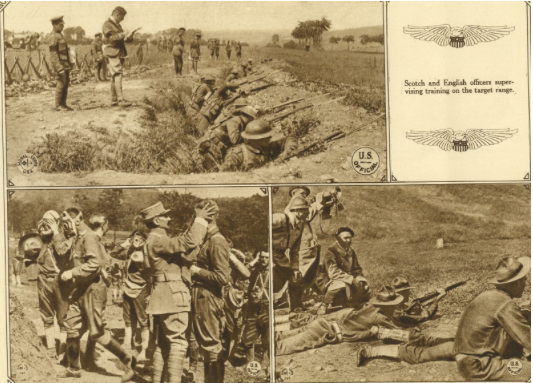This blog post was authored by Sara Matthews, an intern in the Library’s Special Collections unit from the UTC Department of History in Spring 2018.
My intent for the my summer internship was to gain academic experience working with primary and useful secondary sources. Prior to starting my internship with the UTC Special Collections, I expected to have access to interesting dated materials and to enjoy rummaging through them. I did not fully understand before starting their importance and the methodic procedures that are put in place to organize and utilize their significance in the academic community. My goal was to explore resources and activate their agency in the spread of information. I was able to do this by the creation and installation of a physical exhibit dedicated to trench warfare in World War I as well as Chattanooga’s role in the training of soldiers for the war. This exhibit is located in the Grand Roth Reading Room on the 4th floor of the UTC library. I also created a digital finding aid of the Taliaferro Family Papers which will support future research by fellow academics.
My first project was the archival of the Taliaferro Family papers along with creating a digital finding aid using ArchivesSpace software and following Describing Archives: A Content Standard, which is United States implemented and is an internationally acknowledged professional guideline used to describe archival materials and their creators. Hubert Taliaferro, Sr. served in World War I and married Ida Gilbert. They both were born and raised in Chattanooga where Ida’s family lived in Highland Park and Hubert grew up in the historic Fortwood district. The Taliaferro family were native to Chattanooga but had moved around within the southeastern region. They moved back to Chattanooga when their two sons were in middle school. Both sons attended McCallie boarding school where they participated in military training and went on to serve in World War II. The elder brother, Hubert, Jr. was only one year older than Gilbert Taliaferro. Gilbert was 18 when he was sent to France to serve and was the first of his troop to die in service of the American Army. While Hubert, Jr. was also serving in France he was taken as a prisoner of war in Bad Orb. He was liberated in 1945. As I created this finding aid, I realized that working with these primary sources developed a deeper understanding of World War II that I was already aware of. This is the usefulness of primary sources, that they may bring about a stronger education and awareness to not only researchers but also the general public. By making primary and secondary sources readily available through exhibits and finding aids, academic institutions and museums have a direct hand in shaping public opinion and educating the general citizen.
The UTC Special Collections department houses this family’s photo albums and personal documents that I have now made available to be researched through the Special Collections website.


My second project has been an great introduction to what I wish to carry on throughout my future career in library and archival work. I have written and implemented an exhibit on World War I. I researched the ways that soldiers fought within the trenches in europe and the tools they were given to survive. The UTC Special Collections has a number of World War I items such as a uniform, a field seat, a helmet, a handful of dishes and mess kits as well as documents, pictures and books describing the life that soldiers lived while serving in The Great War. These items and many pictures are to be displayed in the Grand Roth Reading Room Fall semester of 2018. Along with the study of World War I, I have been exploring the city of Chattanooga’s role in the training for trench warfare. UTC’s own campus was used in Battery B’s training and allowed local volunteers to unite and form their own coalition that would later join other cities and travel to training camp in South Carolina. They would later go on to serve in the United States Army during World War I. The history of Chattanooga’s Battery B is documented in a book, titled Chattanooga’s Battery B, written by Ernest P. West and is stored in the UTC’s Rare Book Collection. I have loved creating and writing the narrative for this display and I believe that it has been a wonderful learning experience for me as I explore a future in museum curation, archival work and library science.

When the summer first started I was excited to be able to work with rare books and to touch real life historical artifacts. While that eagerness never went away, as I started to actually use these books and artifacts did I actually recognize their importance and agency in the education and spread of information. Displaying these archival objects impresses on their audience a more tangible history that is more concrete and understandable. One can read about WWI helmets but how much more does someone comprehend their utility if they were to see them in a display case? (And if you’re lucky like me, you get to hold one and feel how heavy they are.)
This internship has been a wonderful opportunity for me to explore my future in the world of academia and library science. I have loved being in an environment where if I don’t know something, I have all the resources available to research it. This internship has also provided me with a new found independence. As a student for the past four years, I have been accustomed to earning grades and seeking information for class purposes. This internship and specifically my creation of a physical exhibit has shown me that I am capable of independently writing and creating something that is uniquely my own in a professional and academic context.